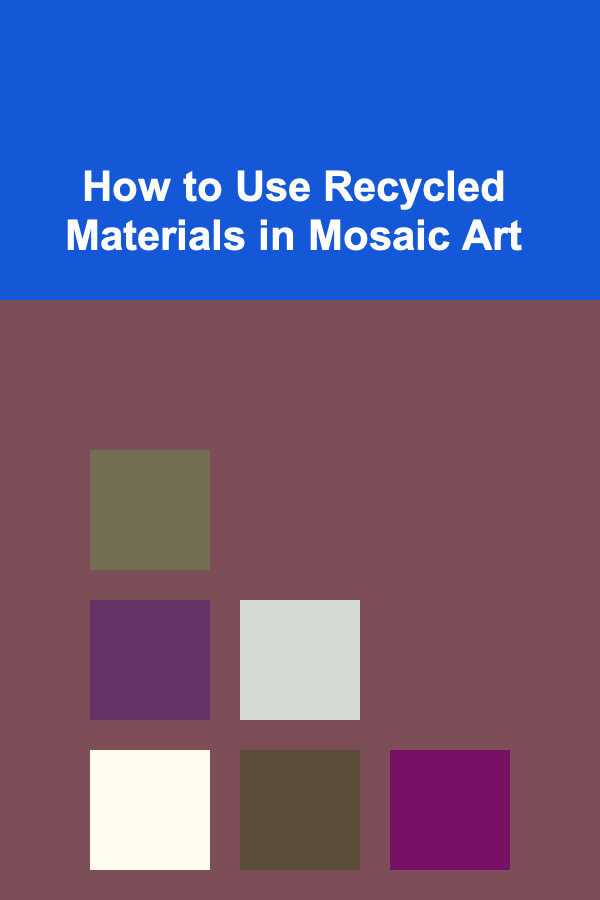
How to Use Recycled Materials in Mosaic Art
ebook include PDF & Audio bundle (Micro Guide)
$12.99$9.99
Limited Time Offer! Order within the next:

Mosaic art is a timeless form of artistic expression that dates back to ancient civilizations, offering intricate patterns and colorful designs. Traditionally, mosaics are made using materials like glass, ceramic, stone, and even tiles. However, in recent years, a growing movement has emerged where artists and creatives are using recycled materials to create beautiful, sustainable art. This approach not only benefits the environment but also adds a unique and personal touch to each piece.
Recycled materials can bring new life to old objects and give them a second chance to shine. Using discarded items---such as old magazines, broken tiles, pieces of metal, plastic, and even glass bottles---artists can create stunning mosaic designs while contributing to a more sustainable world. The process of using recycled materials in mosaic art invites a creative, eco-conscious approach to art that is both imaginative and impactful.
In this article, we will explore how to incorporate recycled materials into mosaic art, the different types of materials you can use, and step-by-step instructions for creating your own unique recycled mosaic masterpieces.
The Benefits of Using Recycled Materials in Mosaic Art
The use of recycled materials in art has several key benefits:
1.1. Environmental Sustainability
One of the most significant advantages of using recycled materials in mosaic art is its positive impact on the environment. By reusing materials that would otherwise end up in landfills, artists reduce waste and promote a more sustainable approach to creating art. This not only helps keep discarded items out of landfills but also decreases the demand for new raw materials, conserving natural resources.
1.2. Unique and Diverse Textures
Recycled materials offer an opportunity to experiment with various textures and finishes that are not typically available with traditional mosaic tiles. Using items like pieces of broken glass, old jewelry, scrap metal, or plastic bottle caps allows for a wide range of textures, from shiny and smooth to rough and gritty. These unique textures add character and depth to the mosaic, making each piece distinct and one-of-a-kind.
1.3. Cost-Effectiveness
Many recycled materials are free or inexpensive, making them an affordable option for artists, especially those on a budget. Collecting discarded materials from household items, thrift stores, or even trash bins allows artists to gather a variety of materials without spending a lot of money. This makes mosaic art accessible to a wider range of people, from hobbyists to professional artists.
1.4. Creativity and Innovation
Using recycled materials encourages creativity and innovation. The limitations imposed by working with recycled objects can push artists to think outside the box and come up with novel solutions to create their designs. Instead of relying on commercially produced mosaic tiles, artists are forced to find ways to incorporate diverse materials into their work, fostering greater creativity and problem-solving skills.
Types of Recycled Materials for Mosaic Art
There are countless materials that can be used in mosaic art, and the possibilities are limited only by your imagination. Here are some of the most common recycled materials you can use:
2.1. Glass and Bottles
Old glass bottles, jars, and broken glass can be used to create stunning mosaics. The glass can be cut into small, colorful pieces and arranged to form intricate patterns or images. Recycled glass has a beautiful reflective quality, which can add a shimmering effect to your mosaic.
How to Use Glass:
- Break glass bottles into manageable pieces using a glass cutter or by carefully tapping them with a hammer.
- Wear protective gloves and glasses when handling glass to avoid injury.
- Arrange the glass pieces according to your design, and use adhesive to hold them in place.
2.2. Broken Ceramic Tiles
Ceramic tiles that are chipped, cracked, or otherwise damaged are perfect for use in mosaic art. The different colors, textures, and patterns found in broken ceramic tiles can create a vibrant and eye-catching mosaic design.
How to Use Ceramic Tiles:
- Break the tiles into smaller pieces using a tile cutter or hammer.
- Clean off any sharp edges by grinding the pieces with a tile grinder.
- Use a tile adhesive or mortar to stick the pieces to your chosen surface.
2.3. Plastic Bottles and Caps
Plastic bottles, caps, and other plastic containers can be repurposed into mosaic art. The colorful nature of plastic items, especially bottle caps, allows artists to experiment with different patterns and hues.
How to Use Plastic:
- Cut plastic bottles into flat pieces or use bottle caps as individual pieces.
- Arrange the plastic pieces to form a pattern, making sure to mix colors for added visual interest.
- Use strong glue or adhesive to affix the plastic to the surface.
2.4. Old Magazines, Newspapers, and Paper
Old magazines, newspapers, and scrap paper are great sources of colorful, printed material that can be used in mosaics. By cutting out shapes, images, and patterns from paper, you can create stunning collages with a unique aesthetic.
How to Use Paper:
- Cut out the desired images, patterns, or words from old magazines or newspapers.
- Arrange them on your surface, experimenting with different placements to form your design.
- Once satisfied, glue the pieces down and apply a layer of varnish to seal and protect your work.
2.5. Metal Scraps
Scraps of metal from old cans, aluminum foil, or even discarded jewelry can be used to add a shiny, reflective quality to your mosaic art. Metal pieces can be cut, shaped, or flattened to fit your design.
How to Use Metal:
- Cut metal scraps into smaller pieces using metal shears or a cutting tool.
- Flatten or shape the metal pieces as needed.
- Secure the metal pieces to your surface using strong adhesive.
2.6. Wood and Driftwood
Wood, especially driftwood, can provide a natural and earthy texture for your mosaic. Pieces of wood can be cut, sanded, and painted to create a rustic or organic feel in your artwork.
How to Use Wood:
- Collect small pieces of wood or driftwood.
- Sand and paint the pieces if necessary to enhance the visual appeal.
- Arrange the pieces on your surface and glue them into place.
Tools and Materials Needed for Mosaic Art
To create your own mosaic art with recycled materials, you will need the following tools and materials:
- Surface: Choose a solid surface to adhere your materials to, such as plywood, a wooden frame, or even a wall.
- Adhesive: You'll need a strong adhesive, such as tile adhesive or craft glue, to secure your materials.
- Grout: Once the materials are affixed, grout helps fill in the gaps and create a smooth, finished look.
- Tile Cutter: For breaking and cutting ceramic tiles, glass, and other hard materials.
- Hammer and Protective Gear: When breaking larger materials like glass or ceramics, make sure to wear gloves and protective glasses to avoid injury.
- Trowel or Spatula: Use this tool for spreading adhesive and applying grout.
Step-by-Step Guide to Creating a Recycled Mosaic
Creating a recycled mosaic involves several steps, from planning your design to the final grout application. Follow these steps to make your own mosaic using recycled materials:
4.1. Choose Your Materials
Start by collecting recycled materials, such as broken tiles, glass bottles, metal scraps, or paper. Sort through your materials and select the ones that fit your aesthetic or color scheme. Make sure to clean and prepare your materials before you begin.
4.2. Prepare Your Surface
Select a sturdy surface for your mosaic, such as a wooden board or a piece of furniture. If you're working on a flat surface like a table or wall, ensure it is clean and smooth. You can even paint the surface to match your design before beginning the mosaic process.
4.3. Design Your Mosaic
Plan your mosaic design, keeping in mind the colors, textures, and shapes of the recycled materials you're using. You can sketch the design directly onto the surface or use a printed image as a template. Decide whether you want to create an abstract design or a recognizable image, such as a floral pattern or geometric shapes.
4.4. Cut and Shape Your Materials
If necessary, cut your materials into smaller pieces. You can use a tile cutter for ceramic pieces, scissors for paper, or a hammer for breaking glass and ceramics. Shape your materials according to your design, and make sure to smooth out any sharp edges.
4.5. Apply Adhesive and Place Your Materials
Using a strong adhesive, start placing your materials onto the surface. Work in small sections, starting from the center or one corner of the design. Press each piece firmly into the adhesive to ensure it sticks. Continue adding pieces until your design is complete.
4.6. Apply Grout and Finish the Design
Once the adhesive has dried, apply grout over the surface to fill in the gaps between the materials. Use a trowel or spatula to spread the grout evenly. Wipe off any excess grout with a damp sponge and allow the grout to dry. Once it's dry, you can polish the surface for a shiny, finished look.
Conclusion
Recycled mosaic art is not only a great way to reduce waste and contribute to sustainability, but it also allows artists to experiment with new materials and create unique, one-of-a-kind pieces. Whether you're working with glass, ceramics, plastic, or metal, the possibilities for using recycled materials in mosaic art are endless. By following the steps outlined in this guide, you can create stunning artwork that combines creativity, sustainability, and environmental consciousness. So, gather your recycled materials and start creating your own mosaic masterpiece today!
Reading More From Our Other Websites
- [Organization Tip 101] How to Incorporate a Pressing Station in Your Sewing Room
- [Biking 101] The Importance of Bike Hydration: Tips for Keeping Your Energy Up
- [Home Renovating 101] How to Transform Your Attic into a Usable Space During a Renovation
- [Soap Making Tip 101] Common Soap-Making Mistakes and How to Fix Them
- [Home Pet Care 101] How to Bathe Your Pet Properly at Home
- [Needle Felting Tip 101] Step-by-Step Needle Felting Projects: From Cute Animals to Stunning Sculptures
- [Personal Finance Management 101] How to Update Your Will and Trust After Major Life Changes
- [Organization Tip 101] How to Organize Dog Walking Gear for Quick Outings
- [Home Family Activity 101] How to Set Up a Family Picnic Indoors When the Weather Isn't Ideal
- [Personal Care Tips 101] How to Choose Mouthwash for a Long-Lasting Fresh Feel

How to Maintain a Clean Home with a Busy Family
Read More
How to Organize Your Kitchen with Smart Storage Hacks
Read More
How to Plan a Family Karaoke Night in Your Living Room
Read More
How to Thicken Sauces Naturally
Read More
10 Tips for Technical Writing in Agile Environments
Read More
10 Tips for Optimizing Plumbing System Energy Efficiency
Read MoreOther Products

How to Maintain a Clean Home with a Busy Family
Read More
How to Organize Your Kitchen with Smart Storage Hacks
Read More
How to Plan a Family Karaoke Night in Your Living Room
Read More
How to Thicken Sauces Naturally
Read More
10 Tips for Technical Writing in Agile Environments
Read More